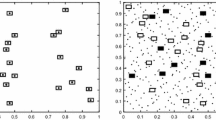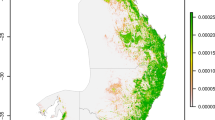Abstract
Adaptive sampling designs are becoming increasingly popular in environmental science, particularly for surveying rare and aggregated populations. An adaptive sample is one in which the survey design is modified, or adapted, in some way on the basis of information gained during the survey. There are many different adaptive survey designs that can be used to estimate animal and plant abundance. In adaptive cluster sampling, additional sample effort is allocated during the survey to the immediate neighborhood in which the species is found. In adaptive stratified sampling, additional sample effort is allocated during the survey to strata of high abundance. The appealing feature of these adaptive designs is that the field biologist gets to do what innately seems sensible when working with rare and aggregated populations—field effort is targeted around where the species is observed in the first wave of the survey. However, there are logistical challenges of applying this principle of targeted field effort while remaining in the framework of probability-based sampling. We propose a simplified adaptive survey design that incorporates both targeting field effort and being logistically feasible. We show with a case study population of rockfish that complete allocation stratified sampling is a very efficient design.

Similar content being viewed by others
References
Brown JA, Manly BFJ (1998) Restricted adaptive cluster sampling. Environ Ecol Stat 5:47–62
Brown JA, Salehi MM, Moradi M, Smith DR (2008) Two-stage sequential design for sampling rare and clustered populations. Popul Ecol 50:239–245
Cochran WG (1977) Sampling techniques, 3rd edn. Wiley, New York
Francis RICC (1984) An adaptive strategy for stratified random trawl surveys. N Z J Mar Freshw Res 18:59–71
Goldberg NA, Heine JN, Brown JA (2007) The application of adaptive cluster sampling for rare subtidal macroalgae. Mar Biol 151:1343–1348
Jolly GM, Hampton I (1990) A stratified random transect design for acoustic surveys of fish stocks. Can J Fish Aquat Sci 4:1282–1291
Lo NCH, Smith PE, Takahashi M (2009) Egg, larval and juvenile surveys. In: Jakobsen T, Fogarty MJ, Megrey BA, Moksness E (eds) Fish reproductive biology: implications for assessment and management. Wiley and Blackwell, Oxford, pp 207–229
Philippi T (2005) Adaptive cluster sampling for estimation of abundances within local populations of low-abundance plants. Ecology 86:1091–1100
Salehi MM, Smith DR (2005) Two-stage sequential sampling: a neighborhood-free adaptive sampling procedure. J Agric Biol Environ Stat 10:84–103
Seber GAF, Salehi MM (2004) Adaptive sampling. In: Armitage P, Colton T (eds) Encyclopedia of biostatistics, vol 1, 2nd edn. Wiley, Chichester, pp 59–65
Smith SJ, Lundy MJ (2006) Improving the precision of design-based scallop drag surveys using adaptive allocation methods. Can J Fish Aquat Sci 63:1639–1646
Smith DR, Brown JA, Lo NCH (2004) Application of adaptive cluster sampling to biological populations. In: Thompson WL (ed) Sampling rare and elusive species. Island Press, Washington, DC, pp 75–122
Su Z, Quinn TJ II (2003) Estimator bias and efficiency for adaptive cluster sampling with order statistics and a stopping rule. Environ Ecol Stat 10:17–41
Sullivan WP, Morrison BJ, Beamish WH (2008) Adaptive cluster sampling: estimating density of spatially autocorrelated larvae of the sea lamprey with improved precision. J Great Lakes Res 34:86–97
Thompson SK (1990) Adaptive cluster sampling. J Am Stat Assoc 85:1050–1059
Thompson SK (1992) Sampling. Wiley, New York
Thompson SK, Seber GAF (1996) Adaptive sampling. Wiley, New York
Turk P, Borkowski JJ (2005) A review of adaptive cluster sampling: 1990–2003. Environ Ecol Stat 12:55–94
Acknowledgments
We thank two referees and an editor for their constructive comments on the early draft of this paper.
Author information
Authors and Affiliations
Corresponding author
Rights and permissions
About this article
Cite this article
Salehi, M., Brown, J.A. Complete allocation sampling: an efficient and easily implemented adaptive sampling design. Popul Ecol 52, 451–456 (2010). https://doi.org/10.1007/s10144-010-0196-7
Received:
Accepted:
Published:
Issue Date:
DOI: https://doi.org/10.1007/s10144-010-0196-7




